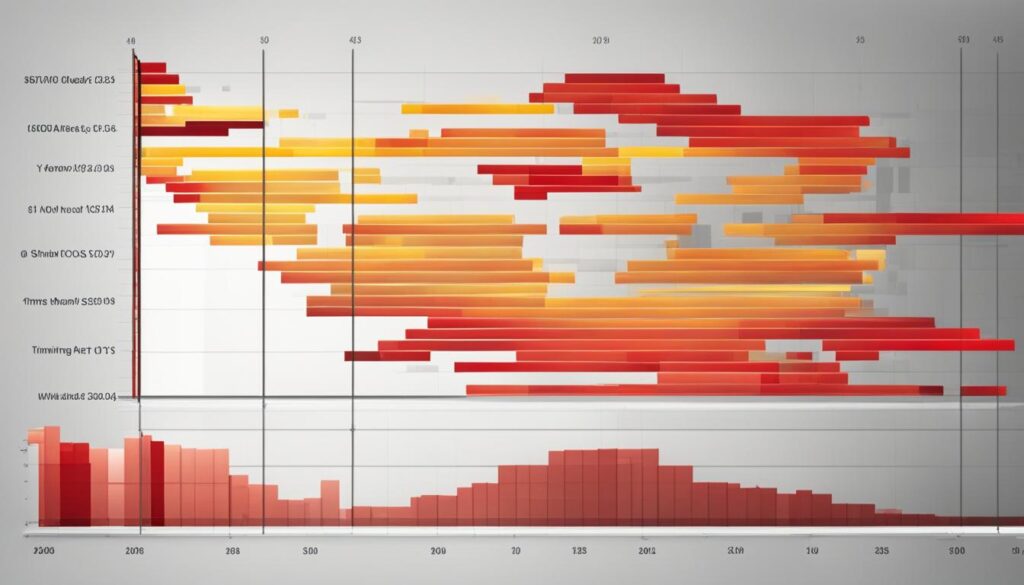In your 30s, it is crucial to understand the true cost of health and how it can impact your finances. Health spending in this age group can have a significant impact on your budget and long-term financial well-being. It is important to be aware of the expenses associated with maintaining good health and plan accordingly to ensure a healthier future.
Key Takeaways
- Health spending in your 30s can have a significant impact on your budget and long-term financial well-being.
- It is important to be aware of the expenses associated with maintaining good health.
- Planning and budgeting for health can ensure a healthier future.
- Consider investing in a health savings account (HSA) to maximize benefits and save for retirement.
- Having adequate health insurance coverage is essential to protect against unforeseen healthcare expenses.
The Benefits of Health Savings Accounts (HSAs)
A health savings account (HSA) is a versatile financial tool that offers numerous benefits beyond emergency medical savings. It provides individuals with a tax-advantaged way to save and pay for qualified medical expenses, while also offering the potential for long-term retirement savings. Understanding the advantages of HSAs can help individuals make informed decisions about their healthcare and financial future.
Tax Advantages
One of the key benefits of an HSA is the tax advantages it provides. Contributions made to an HSA are tax-deductible, meaning individuals can reduce their taxable income while saving for future healthcare expenses. Additionally, any growth within the HSA account is tax-free, allowing savings to potentially grow faster than in a traditional savings account. This tax-free growth can be particularly advantageous when saving for retirement, as individuals can use their HSA funds to cover medical expenses in retirement without incurring federal income taxes.
Flexible Use of Funds
HSAs offer flexibility in how funds can be used to cover medical expenses. Qualified medical expenses include a wide range of healthcare costs, including doctor visits, prescription medications, and preventive care. Unlike flexible spending accounts (FSAs), funds contributed to an HSA can roll over from year to year, allowing individuals to accumulate savings over time. This flexibility allows individuals to save for both current and future healthcare needs, providing a financial safety net for unexpected medical expenses.
Investment Opportunities
Another advantage of HSAs is the ability to invest contributions and potentially grow savings over time. Many HSA providers offer investment options, such as mutual funds or stocks, allowing individuals to take advantage of potential market growth. By investing HSA funds, individuals have the opportunity to grow their savings at a faster rate, maximizing the benefits of their HSA for both healthcare expenses and long-term retirement savings.
| Benefits of HSAs | |
|---|---|
| Tax advantages | Contributions are tax-deductible, and growth is tax-free |
| Flexible use of funds | Can be used for a wide range of qualified medical expenses |
| Investment opportunities | Ability to invest contributions and potentially grow savings |
In conclusion, health savings accounts (HSAs) offer individuals a unique tool to save and pay for medical expenses while also providing potential long-term retirement savings. The tax advantages of HSAs, along with the flexibility in using funds and investment opportunities, make them an attractive option for individuals looking to strengthen their financial security in the face of healthcare expenses. By understanding the benefits of HSAs and incorporating them into a comprehensive financial plan, individuals can proactively prepare for their healthcare needs while also building a foundation for a secure financial future.
The Rising Healthcare Costs in the United States
The United States is grappling with a significant challenge: the skyrocketing healthcare costs that continue to burden the nation’s economy. As healthcare spending reached a staggering $4.3 trillion in 2021, it poses a serious threat to the fiscal situation and the ability to effectively respond to public health crises, such as the recent COVID-19 pandemic.
Over the past few decades, healthcare costs in the United States have been on an alarming upward trajectory. In 1960, healthcare spending accounted for just 5% of the country’s GDP. Fast forward to 2021, and it now stands at a staggering 18%. This unsustainable growth is primarily driven by factors such as an aging population and the ever-increasing prices of healthcare services. It is a challenge that requires immediate attention and effective solutions.
One of the key contributors to rising healthcare costs is the aging population in the United States. As more individuals reach the age of 65 and above, they naturally require more healthcare services, leading to higher overall healthcare costs. In fact, the number of Medicare enrollees is projected to see a substantial increase in the coming years, which will further drive up Medicare spending. It is crucial to address the impact of an aging population on healthcare costs to ensure the long-term sustainability of the healthcare system and the nation’s financial well-being.

Moreover, the increasing cost of healthcare services has also played a significant role in the escalating healthcare spending in the United States. Healthcare services tend to have higher cost growth rates compared to other goods and services in the economy. With an average annual growth rate of 3.2%, medical care costs have outpaced the overall inflation rate of 2.5%. Factors such as new healthcare technology, administrative waste, and hospital consolidation contribute to the rising prices, exacerbating the financial burden on individuals and the nation as a whole.
The rising healthcare costs in the United States have far-reaching implications, not only on individuals’ financial well-being but also on the national debt and the country’s overall economy. To address this critical issue, it is imperative to explore effective strategies that can help mitigate healthcare spending, improve cost transparency, and ensure access to affordable healthcare for all.
The Impact of Aging Population on Healthcare Costs
The aging population in the United States has a significant impact on healthcare costs. As people age, they tend to require more medical services and treatments, which can drive up expenses. With the share of the population aged 65 and over increasing, the healthcare costs associated with this age group are also rising.
One of the main factors contributing to the increase in healthcare costs is Medicare spending. As more individuals reach the age of 65, they become eligible for Medicare, a federally funded health insurance program. The number of Medicare enrollees is projected to grow substantially in the coming years, leading to a significant increase in Medicare spending. In fact, it is estimated that Medicare spending will nearly double over the next 30 years relative to the size of the economy.
To put it into perspective, let’s take a look at the following table, which illustrates the projected growth in the number of Medicare enrollees and corresponding healthcare costs:
| Year | Number of Medicare Enrollees | Medicare Spending (in billions) |
|---|---|---|
| 2021 | 63 million | $849 |
| 2030 | 74 million | $1,403 |
| 2040 | 82 million | $2,143 |
| 2050 | 89 million | $3,379 |
As the table shows, both the number of Medicare enrollees and Medicare spending are expected to increase significantly over time. This growing demand for healthcare services from the aging population poses a substantial challenge for the healthcare system and highlights the need for effective strategies to manage and control healthcare costs.

The Increasing Cost of Healthcare Services
The cost of healthcare services in the United States has been steadily rising, putting a strain on individuals, families, and the overall economy. With healthcare prices typically growing faster than other goods and services, it is crucial to understand the factors contributing to this increase and the implications for healthcare spending.
One of the main drivers of rising healthcare prices is the constant advancement of healthcare technology. While these new innovations can lead to improved patient outcomes, they also come with a hefty price tag. The cost of developing and implementing new medical treatments, drugs, and procedures can significantly contribute to the inflation of healthcare prices.
Another factor that contributes to the increasing cost of healthcare services is the administrative waste within the healthcare system. The complexity of billing processes, insurance claims, and paperwork adds significant overhead costs to healthcare providers, which are ultimately passed on to patients. Streamlining administrative processes and reducing paperwork could help alleviate some of these costs.
Quote: “The cost of medical care has grown at an average rate of 3.2% per year, compared to an average inflation rate of 2.5% for other goods and services.”
Hospital consolidation is also a significant contributor to the rising cost of healthcare services. Many hospitals and healthcare systems have merged or acquired smaller facilities, leading to a lack of competition in certain areas. This lack of competition can result in higher prices for services, as there is less incentive for providers to offer competitive pricing.
| Factors contributing to the increasing cost of healthcare services | Impact on healthcare prices |
|---|---|
| New healthcare technology | Higher costs for developing and implementing new treatments and procedures |
| Administrative waste | Additional overhead costs for healthcare providers, passed on to patients |
| Hospital consolidation | Lack of competition leading to higher prices for services |

The Importance of Health Insurance for Young Adults
Young adults often underestimate the importance of health insurance and the potential financial risks that can arise from unexpected healthcare expenses. While being young and healthy may seem like a reason to forgo coverage, it is essential to consider the long-term benefits and protection that health insurance provides.
Health insurance offers affordable coverage that can help mitigate the financial burden of healthcare expenses. Many young adults may assume that health insurance is costly, but with the availability of subsidies through the Marketplace, coverage can be more affordable than expected. These subsidies are designed to make insurance premiums more affordable based on income and can significantly lower the cost of coverage.
Having health insurance provides protection and peace of mind in the face of unforeseen circumstances. Accidents and illnesses can happen to anyone, regardless of age or health status. Without insurance, the cost of medical treatment can quickly accumulate, leading to substantial out-of-pocket expenses that can strain your finances.
Furthermore, health insurance not only offers protection against healthcare expenses but also ensures access to quality care. With comprehensive coverage, individuals can receive necessary medical services, including preventive care, mental health services, and coverage for pre-existing conditions. This comprehensive coverage helps promote proactive health management and ensures that individuals can address their healthcare needs without incurring significant costs.

The Coverage and Benefits of Health Insurance
Health insurance is a vital aspect of ensuring comprehensive coverage for individuals and their families. These insurance plans offer a wide range of benefits, providing access to necessary healthcare services without incurring significant costs. Let’s explore the coverage and benefits of health insurance plans available through the Marketplace.
Comprehensive Coverage
Health insurance plans offer comprehensive coverage that includes various essential services. These plans typically cover emergency room services, doctor and hospital charges, pregnancy and pre-existing conditions, mental health and substance abuse services, and preventive services for all adults and children. By providing comprehensive coverage, health insurance plans ensure individuals can receive the necessary care they need without worrying about the financial burden.
Preventive Services
One of the key advantages of health insurance is access to preventive services. Preventive care plays a crucial role in maintaining good health and preventing the onset of chronic conditions. Health insurance plans cover a wide range of preventive services, such as vaccinations, screenings for various diseases, and counseling on healthy lifestyle choices. Regular preventive care not only promotes better health outcomes but also helps individuals detect and address potential health issues at an early stage.
Mental Health Coverage
Health insurance plans also include coverage for mental health services, ensuring individuals have access to the necessary care and support for their mental well-being. Mental health coverage typically includes services like counseling, therapy sessions, and treatment for mental health conditions. By offering comprehensive mental health coverage, health insurance plans prioritize the holistic health of individuals and recognize the importance of mental well-being.
Overall, health insurance plans provide comprehensive coverage, encompassing a wide range of healthcare services. These plans not only protect individuals and their families from unexpected healthcare expenses but also promote preventive care and support mental well-being. With the diverse benefits they offer, health insurance plans play a crucial role in ensuring individuals can access quality healthcare without facing significant financial burden.
Conclusion
As you enter your 30s, it is crucial to understand the true cost of health and its long-term financial impact. The rising healthcare costs in the United States, coupled with the impact of an aging population, highlight the importance of planning for future expenses. By investing in a health savings account (HSA) and obtaining adequate health insurance coverage, you can secure your financial stability and protect yourself against unforeseen healthcare expenses.
Budgeting for health spending in your 30s is a wise decision. Take into account the increasing healthcare costs that the United States faces, totaling a staggering $4.3 trillion in 2021 alone. Understanding the factors contributing to these rising costs, such as an aging population and increasing healthcare prices, can help you prepare for the future and ensure financial well-being.
Moreover, having health insurance coverage is essential for young adults. Protect yourself from the potential financial burden of unexpected healthcare expenses by obtaining affordable coverage. Marketplace plans offer comprehensive coverage including emergency services, doctor charges, mental health services, preventive care, and more. This ensures that you can access necessary healthcare services without incurring significant costs and offers peace of mind for your long-term financial future.
By prioritizing your health and being proactive in your 30s, you can achieve long-term financial stability and a healthier future. Consider the true cost of health, invest in an HSA, and secure adequate health insurance coverage to safeguard your finances and protect against unforeseen healthcare expenses. By taking these steps, you can navigate the complexities of healthcare costs and ensure a brighter financial outlook in the years to come.
FAQ
What is the true cost of health in your 30s?
The true cost of health in your 30s includes health spending, which can have a significant impact on your budget and long-term financial well-being. It is important to be aware of the expenses associated with maintaining good health and plan accordingly to ensure a healthier future.
What are the benefits of health savings accounts (HSAs)?
Health savings accounts (HSAs) are not just for emergency medical savings. They can also help you pay for qualified medical expenses and save for retirement. Contributing to an HSA early and often can maximize its benefits, including tax advantages and the ability to invest contributions without paying federal income taxes on any growth.
What are the rising healthcare costs in the United States?
Healthcare spending in the United States has been increasing over the past few decades, reaching $4.3 trillion in 2021. Factors contributing to rising costs include an aging population and increasing healthcare prices. High healthcare costs not only strain the fiscal situation but also affect the country’s ability to respond to public health crises like the COVID-19 pandemic.
What is the impact of the aging population on healthcare costs?
As the share of the population age 65 and over increases, healthcare costs associated with this age group also rise. The number of older Americans spending more on healthcare is expected to increase total healthcare costs. The number of Medicare enrollees is also projected to grow substantially, leading to increased Medicare spending.
Why are healthcare services becoming more expensive?
Prices play a significant role in healthcare spending in the United States, with healthcare services’ costs typically growing faster than other goods and services in the economy. Several factors contribute to the increase in healthcare prices, including new healthcare technology, administrative waste in the healthcare system, and hospital consolidation leading to a lack of competition.
Why is health insurance important for young adults?
Young and healthy individuals may think they don’t need health insurance, but it is important to consider the potential financial burden of unexpected healthcare expenses. Health insurance can be more affordable than expected, especially with the availability of subsidies through the Marketplace. It provides protection and quality care when unforeseen circumstances occur, preventing extensive out-of-pocket costs that could limit future financial options.
What does health insurance cover?
Health insurance plans offered through the Marketplace provide comprehensive coverage, including emergency room services, doctor and hospital charges, pregnancy and pre-existing conditions, mental health and substance abuse services, and preventive services for all adults and children. Some plans also include dental coverage.
Why is it important to consider the true cost of health in your 30s?
Understanding the true cost of health in your 30s, including rising healthcare costs and the impact of an aging population, can help you budget accordingly and prepare for future expenses. Investing in a health savings account (HSA) and having adequate health insurance coverage can provide financial security and protect against unforeseen healthcare expenses, leading to long-term financial stability and a healthier future.


Pingback: Healthy Debt: Balancing Your Well-being with Student Loans! – Straight Fire Money